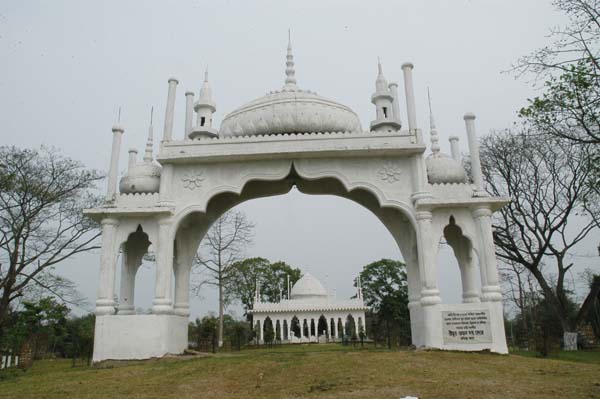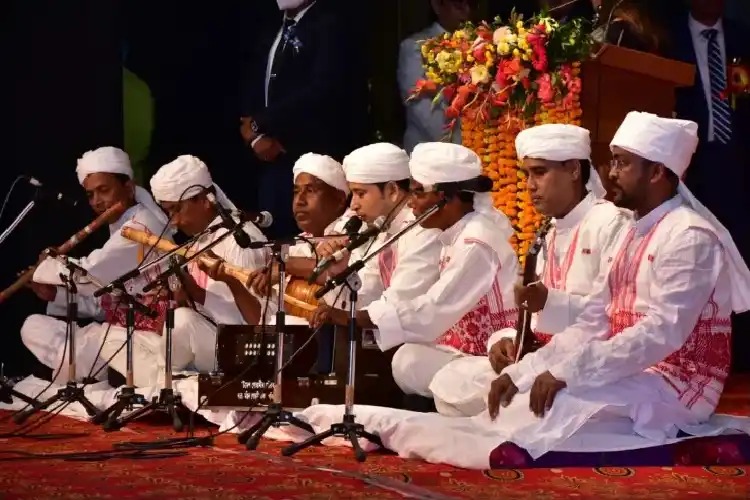Introduction to Ajan Pir Dargah

Ajan Pir Dargah, located in Sivasagar, Assam, is one of the most revered spiritual sites in the region. It is the resting place of the great Sufi saint Hazrat Shah Miran, popularly known as Ajan Pir. This dargah attracts thousands of devotees from various communities, symbolizing the unity of different faiths. The site is known not just for its religious significance but also for its cultural and historical importance in Assam.
The Life and Legacy of Ajan Pir
Ajan Pir, originally from Baghdad, arrived in Assam during the 17th century, at a time when the Ahom dynasty ruled the region. His arrival marked the spread of Islamic teachings in Assam, but what set him apart was his approach to Sufism, which blended local traditions with Islamic beliefs. He emphasized peace, unity, and devotion to one God while respecting the customs and cultures of Assam. His teachings found a deep connection with the local population, and he played a crucial role in shaping Assamese Muslim culture.
One of his most significant contributions was the introduction of Zikir and Zari, devotional songs in Assamese that combined Islamic teachings with the essence of Assamese folk traditions. These songs are still sung today and hold immense cultural value.
Architectural and Cultural Significance of the Dargah
The Ajan Pir Dargah stands as a remarkable example of Assamese and Islamic architectural fusion. The dargah complex is simple yet serene, radiating a spiritual aura that draws people irrespective of their religion. The site is surrounded by lush greenery, adding to its tranquility.
Pilgrims visit the dargah to seek blessings, offer prayers, and pay homage to Ajan Pir’s tomb. Many believe that the saint possesses divine powers, and numerous devotees claim to have received spiritual solace after visiting the shrine. The dargah also serves as a center of learning where religious teachings and the values of Sufism are shared.
The Urus Festival: A Grand Spiritual Gathering
One of the most significant events held at Ajan Pir Dargah is the Urus Festival, an annual event commemorating the saint’s death anniversary. Urus is observed with great devotion and attracts thousands of visitors from across Assam and beyond.
Rituals and Ceremonies
During the festival, special prayers and Quranic recitations are held at the dargah. Devotees offer flowers, chadors (cloth coverings), and incense at the saint’s tomb, seeking blessings for prosperity, health, and peace. The dargah committee organizes spiritual discourses, where scholars discuss Ajan Pir’s teachings and their relevance in modern society.
Zikir and Zari Performances

One of the most captivating aspects of the Urus festival is the recitation of Zikir and Zari. These devotional songs are performed by groups of singers who chant in melodious rhythms, creating an atmosphere of deep spirituality. These songs, composed by Ajan Pir himself, have been passed down through generations and are considered sacred in Assamese Muslim culture.
Community Feast and Social Harmony
A significant part of the Urus festival is the Mehfil and Langar (community feast), where food is served to all visitors, irrespective of their caste, creed, or religion. This reflects the saint’s core message of unity and equality. Volunteers from different communities come together to prepare and distribute food, reinforcing the idea of communal harmony that Ajan Pir preached.
Ajan Pir’s Influence on Assamese Society
Ajan Pir’s impact on Assamese society goes beyond religious teachings. His contributions to Assamese literature and music have left a lasting legacy. The Zikir and Zari tradition is now recognized as an integral part of Assamese culture, and efforts have been made to preserve and promote these devotional songs through various cultural organizations.
Moreover, the values he propagated—peace, love, and respect for all—continue to influence the social fabric of Assam. His teachings have inspired generations to embrace spirituality without disregarding their indigenous cultural roots.
How to Visit Ajan Pir Dargah
The dargah is located in Sivasagar, Assam, a historically rich town known for its Ahom-era monuments. Travelers can reach Sivasagar by road, rail, or air:
- By Air: The nearest airport is Jorhat Airport (Rowriah), about 70 km from Sivasagar. From the airport, taxis and buses are available to reach the town.
- By Rail: The closest railway station is Simaluguri Junction, around 16 km from Sivasagar. Regular trains connect it to major cities like Guwahati, Dibrugarh, and Kolkata.
- By Road: Sivasagar is well-connected by road, and state-run buses, private cabs, and shared taxis operate from Guwahati, Jorhat, and Dibrugarh.
The best time to visit the dargah is during the Urus Festival, when the place is adorned with lights, prayers resonate through the air, and devotees come together to celebrate the life of Ajan Pir.
Conclusion
Ajan Pir Dargah in Sivasagar is more than just a religious site—it is a symbol of spiritual harmony, cultural heritage, and Assamese identity. The Urus festival held here every year strengthens communal bonds and revives the teachings of a saint who dedicated his life to spreading love and unity. Whether you are a devotee, a history enthusiast, or a cultural explorer, a visit to this sacred site offers a profound experience of faith, tradition, and peace.
FAQ’s
Q. Who was Ajan Pir, and why is he revered in Assam?
Ajan Pir, also known as Hazrat Shah Miran, was a 17th-century Sufi saint from Baghdad who played a crucial role in spreading Islam in Assam. He is revered for his spiritual teachings, introduction of Zikir and Zari devotional songs, and his message of peace and communal harmony.
Q. Where is Ajan Pir Dargah located, and how can one visit?
Ajan Pir Dargah is situated in Sivasagar, Assam. It is well connected by road, rail, and air. The nearest airport is Jorhat Airport (Rowriah), 70 km away, and the closest railway station is Simaluguri Junction, 16 km away. State-run and private buses also operate from Guwahati, Jorhat, and Dibrugarh.
Q. What is the significance of the Urus Festival at Ajan Pir Dargah?
The Urus Festival marks the death anniversary of Ajan Pir and is celebrated with great devotion. It includes special prayers, Zikir and Zari performances, Quranic recitations, and a community feast, attracting thousands of devotees from various communities.
Q. What are Zikir and Zari, and how did Ajan Pir contribute to them?
Zikir and Zari are Assamese devotional songs introduced by Ajan Pir. They blend Islamic teachings with local Assamese folk traditions, promoting spirituality, love, and devotion to God. These songs are still widely performed and preserved as part of Assam’s rich cultural heritage.
Q. What rituals are performed at Ajan Pir Dargah?
Devotees offer flowers, chadors (cloth coverings), and incense at the saint’s tomb, seeking blessings for peace, prosperity, and health. Special Quranic recitations, prayers, and spiritual discourses are held during the Urus festival.












